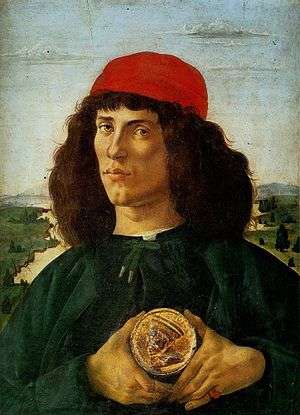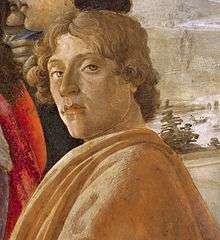Portrait of a Man with a Medal of Cosimo the Elder
 | |
| Artist | Sandro Botticelli |
|---|---|
| Year | c. 1474–1475 |
| Medium | Tempera on panel |
| Dimensions | 57.5 cm × 44 cm (22.6 in × 17 in) |
| Location | Uffizi, Florence |
Portrait of a Man with a Medal of Cosimo the Elder, also known as Portrait of a Youth with a Medal, is a tempera painting by Italian Renaissance painter Sandro Botticelli. The painting features a young man displaying in triangled hands a medal stamped with the likeness of Cosimo de' Medici. The identity of the young man has been a long-enduring mystery. Completed in approximately 1475, it is on display in the Uffizi Gallery of Florence.
Composition
Central to the painting, seated before a landscape, is a young man with a medal between his hands. The man gazes out into the audience, while the medal displays the profiled likeness of Cosimo de' Medici. The medal is a pastiglia imitation of a real metal medal, made of gilded gesso and inset into the portrait.[1] As the medal is not reversed, evidently Botticelli either had access to the original mold or made a cast from the medal to produce his gesso.[2] The medal appears to be the same as one possibly designed by Donatello and cast in 1465, an example of which is in the collection of the Victoria and Albert Museum in London, England, called "Cosimo de' Medici as Pater Patriae".[3](link)
The portrait is remarkable in part for the orientation of its subject. In 1997's The Sculptures of Adrea del Verrocchio, Andrew Butterfield suggests that Botticelli may have "attempted to devise a new format for portraits" with this and his Smeralda Bandinelli, by placing his subjects in the same "continuum" with their audience, directly engaging him.[4]
Identity of the subject

The young man in the portrait has never been identified, but there has been considerable speculation. Writing in 1900, art historian George Noble Plunkett colorfully identified whom he believed the youth portrayed:
one realizes painfully that this is the Piero who has left an indelible stain on the Medici family by his betrayal of Florence. The small covetous eyes, the ignoble nose, the pursed animal mouth, with only the restraint of selfishness on it, the very manner in which he holds up the memorial of his house's founder, as though it were his badge of honor![5]
Contemporary biographer Guido Cornini notes other theories held by historians: the youth—who wears garments appropriate to the middle class—may be one of the possible designers of the medal (Michelozzo Niccolò Fiorentino, Cristoforo di Geremia), a member of the Medici family (including, possibly, Cosimo de' Medici himself) or, as he personally felt more likely, Antonio Botticelli, Botticelli's brother.[6] This, he asserts, is based on the strength of the likeness of the youth to Botticelli himself, as portrayed in his Adoration of the Magi. Antonio Botticelli had also recast and gilded medals,[6] working in the court of the Medicis.[7]
.jpg)
The appearance at auction in 1982, from the Thomas Merton collection, of a rarely seen painting by Botticelli of a young man identified as Giovanni il Popolano in a similar pose, holding up a round medal (albeit of a bearded saint, not Cosimo), has led to speculation that this might be a companion piece, and thus that the young man in this portrait is possibly his brother, Lorenzo di Pierfrancesco de' Medici.[8] (the long dark locks and facial features are not dissimilar from those found on Mercury in Botticelli's Primavera, another presumed representation of Lorenzo di Pierfrancesco.) If so, the meaning of the medallion over the heart may simply be a profession of the loyalty of the cadet branch of the Popolani to the branch of Cosimo.
In Botticelli (2004), Sean Connolly says that some critics also believe that the young man may have been a Medici follower, but notes that "the subject is almost as mysterious as Leonardo's Mona Lisa.[9] Gloria Fossi in Uffizi Gallery (2001) calls the subject "one of the most enigmatic models of the Renaissance."[10]
History
The origin of the painting is almost as mysterious as its model. While it is unknown who commissioned it or where it spent the first century of its existence, it passed at some point to Carlo de' Medici.[10] Upon Carlo de' Medici's death in 1666, it entered the collection of the Uffizi. The painting was restored in 1991.
Notes
- ↑ Scher, 27.
- ↑ Randolph (2002), p. 18.
- ↑ Avery, Charles (1994). Donatello: An Introduction. New York, New York: IconEditions. p. 85. ISBN 0-06-430311-X.
- ↑ Butterfield (1997), 100.
- ↑ Plunkett (1900), p. 52.
- 1 2 Cornini (1998), p. 18.
- ↑ Capretti (2002), 14.
- ↑ F. Hartt (1969) A History of Italian Renaissance Art, p.291; C. Kidwell (1989) Marullus: soldier poet of the Renaissance, London: Duckworth, p.269
- ↑ Connolly (2004), p. 15.
- 1 2 Fossi and Galleria degli Uffizi (2001), p. 126.
References
- Bodart, Diane (4 November 2008). Renaissance & Mannerism. Sterling Publishing Company, Inc. ISBN 978-1-4027-5922-2. Retrieved 29 June 2010.
- Butterfield, Andrew (1997). The sculptures of Andrea del Verrocchio. Yale University Press. ISBN 978-0-300-07194-8. Retrieved 30 June 2010.
- Capretti, Elena (1 January 2002). Botticelli. Giunti Editore Firenze Italy. ISBN 978-88-09-21433-0. Retrieved 30 June 2010.
- Connolly, Sean (October 2004). Botticelli. Gareth Stevens. ISBN 978-0-8368-5648-4. Retrieved 29 June 2010.
- Cornini, Guido (1998). Botticelli. Ediz. inglese. Giunti Editore Firenze Italy. ISBN 978-88-09-76266-4. Retrieved 29 June 2010.
- Fossi, Gloria; Galleria degli Uffizi (2001). Uffizi Gallery: art, history, collections. Giunti Editore Firenze Italy. ISBN 978-88-09-01944-7. Retrieved 30 June 2010.
- Malaguzzi, Silvia (2004). Botticelli. Giunti Editore Firenze Italy. ISBN 978-88-09-03677-2. Retrieved 29 June 2010.
- Plunkett, George Noble (1900). Sandro Botticelli. G. Bell and sons. Retrieved 29 June 2010.
- Randolph, Adrian W. B. (2002). Engaging Symbols: gender, politics, and public art in fifteenth-century Florence. Yale University Press. ISBN 978-0-300-09212-7. Retrieved 30 June 2010.
- Scher, Stephen K. (2000). Perspectives on the Renaissance medal. Taylor & Francis. ISBN 978-0-8153-2074-6. Retrieved 30 June 2010.